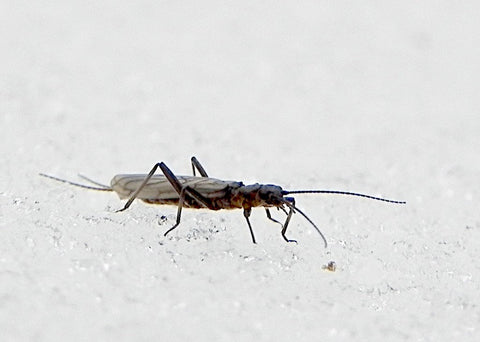Stoneflies mainly live in flowing water. But they can also occur in still water in places with good flow. They generally require very good oxygenation and belong to one of the oldest insects on earth. Hatching usually takes place close to the beach and the winged and adult stonefly like to stay among vegetation and rocks in the beach zone.
In Sweden, 7 families, a total of 39 species, of stoneflies have been found. They have a so-called hemimetabolic development, also called incomplete transformation. This means they go from egg, directly to larva (often called a nymph among fly fishermen) and then hatch into an adult, winged insect called an imago. In the larval stage, they somewhat resemble the larvae of the mayfly, but differ somewhat in that, among other things, they lack long tail spines, but instead have two, shorter and coarser, spines placed on each side of the back of the body. The wings of the adult stonefly are transparent and are positioned directly above the body when they are at rest.
Some species of stoneflies use sound when mating. The female and the male find each other by making a kind of drumming sound with their hind bodies. This is generally called "substratum music" and it is possible to identify a certain species by this sound, as the species that use this technique have different sounds.
Stoneflies require good water quality to thrive. Stooneflies are often overlooked by fly fishermen in Sweden. Not so strange really, because it rarely forms an important part of the fish's diet. The only real time when fishing with dry flies imitating the adult stonefly is when the females lay their eggs. Here, instead, the larval stage is more interesting as these are easier for the fish to find and take. Stoneflies rarely hatch in large numbers, but belong to the species that usually hatch earliest in the season. It is not unusual to see larvae climbing up along the ice to hatch on an early spring day when the sun comes out.
In many other countries, for example the northwestern parts of the USA, they have a greater importance as the number of species is more and some of these are very large in size and hatch abundantly. However, here, in the cold north, it looks different. However, they should not be completely overlooked. Sometimes it happens that the hatches increase and the fishing picks up, but even under such conditions it is primarily imitations of the larva that are interesting to fish with. Among the families and species of stoneflies we have in Sweden, it is really only the size and color that distinguish them. And this may ultimately be limited to two colors and a few sizes. Among fly fishermen, they talk about yellow or black Stoneflies, at least if we stick to the species that are ultimately of interest.

